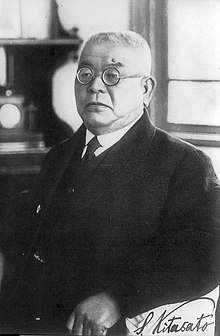Kitasato Shibasaburō
Baron Kitasato Shibasaburō (北里 柴三郎, January 29, 1853 – June 13, 1931) was a Japanese physician and bacteriologist. He is remembered as the co-discoverer of the infectious agent of bubonic plague in Hong Kong in 1894, almost simultaneously with Alexandre Yersin.
Kitasato Shibasaburō | |
|---|---|
 Kitasato Shibasaburō | |
| Born | January 29, 1853 |
| Died | June 13, 1931 (aged 78) Tokyo, Japan |
| Nationality | Japan |
| Known for | bubonic plague |
| Scientific career | |
| Fields | bacteriologist |
| Institutions | Tokyo Imperial University |
| Influences | Robert Koch |
Kitasato was nominated for the first annual Nobel Prize in Physiology or Medicine in 1901.[1] Kitasato and Emil von Behring, working together in Berlin in 1890, announced the discovery of diphtheria antitoxin serum. Von Behring was awarded the 1901 Nobel Prize because of this work, but Kitasato was not.
Biography
Kitasato was born in Okuni village, Higo Province, (present-day Oguni Town, Kumamoto Prefecture, Kyūshū). He was educated at Kumamoto Medical School and Tokyo Imperial University.
He studied under Robert Koch in the University of Berlin from 1885 to 1891. In 1889, he became the first person to grow the tetanus bacillus in pure culture, and in 1890 cooperated with Emil von Behring in developing a serum therapy for tetanus using this pure culture. He also worked on antitoxins for diphtheria and anthrax. Kitasato and Behring demonstrated the value of antitoxin in preventing disease by causing passive immunity to tetanus in an animal that received graded injections of blood serum from another animal infected with the disease.
After returning to Japan in 1891, he founded the Institute for Study of Infectious Diseases with the assistance of Fukuzawa Yukichi. One of his early assistants was August von Wassermann. Kitasato demonstrated how dead cultures can be used in vaccination. He also studied the mode of infection in tuberculosis.
He traveled to Hong Kong in 1894 at the request of the Japanese government during an outbreak of the bubonic plague, and identified a bacterium that he concluded was causing the disease. Yersin, working separately, found the same organism several days later. Because Kitasato's initial reports were vague and somewhat contradictory, some scientific historians give Yersin sole credit for the discovery;[2][3] while others advise dual credit.[4][5][6] However, a thorough analysis of the morphology of the organism discovered by Kitasato by microbiologists determined that although his samples likely became contaminated later, leading to the conflicting reports from his laboratory, there is "little doubt that Kitasato did isolate, study, and reasonably characterize the plague bacillus" in Hong Kong and "should not be denied this credit".[7]
Four years later, Kitasato and his student Shiga Kiyoshi were able to isolate and describe the organism that caused dysentery.
When the Institute for Infectious Diseases was incorporated into Tokyo Imperial University in 1914, he resigned in protest and founded the Kitasato Institute (the forerunner of Kitasato University), which he headed for the rest of his life.
In September 1921, Kitasato founded, together with several medical scientists, the Sekisen Ken-onki Corporation, with the intention of manufacturing the most reliable clinical thermometer possible. The company was later renamed Terumo Corporation.
Kitasato also was the first dean of medicine at Keio University, first president of the Japan Medical Association, and served on the House of Peers. He was ennobled with the title of danshaku (baron) in the kazoku peerage system in February 1924.
Kitasato Shibasaburō died of an intracranial hemorrhage at his home in Azabu, Tokyo, on June 13, 1931. His grave is at the Aoyama Cemetery in Tokyo.
See also
- Kitasato flask, laboratory glassware named in his honor
- Kitasatospora, an Actinobacteria genus named after Kitasato Shibasaburō
- Satoshi Ōmura
References
- Shibasaburo Kitasako - Nomination
- Howard-Jones, Norman (1973). "Was Shibasaburo Kitasato the Co-Discoverer of the Plague Bacilllus?". Perspectives in Biology and Medicine. 16 (Winter): 292–307. doi:10.1353/pbm.1973.0034. PMID 4570035.
- Solomon, Tom (July 5, 1997). "Hong Kong, 1894: the role of James A Lowson in the controversial discovery of the plague bacillus". Lancet. 350 (9070): 59–62. doi:10.1016/S0140-6736(97)01438-4. PMID 9217728.
- Nakase, Yasukiyo (1995). "Kitasato Shibasaburo ni yoru Pesuto-kin hakken to sono shuhen". Nihon Sakingaku Zasshi (50): 637–650.
- Butler, Thomas (1983). Plague and Other Yersinia Infections. New York: Springer. p. 23. ISBN 1468484249.
- Cunningham, Andrew (1992). The Laboratory Revolution in Medicine. Cambridge: Cambridge University Press. pp. 209–244. ISBN 0521524504.
- Bibel, DJ; Chen, TH (September 1976). "Diagnosis of plaque: an analysis of the Yersin-Kitasato controversy". Bacteriological Reviews. 40 (3): 633–651, quote p. 646. PMC 413974. PMID 10879.
Further reading
- Sri Kantha, S. A Centennial review; the 1890 Tetanus antitoxin paper of von Behring and Kitasato and the related developments. Keio Journal of Medicine, March 1991, 40(1): 35-39.
- Sri Kantha, S. The legacy of von Behring and Kitasato. Immunology Today, Sept.1992, 13(9): 374.
- Kyle, Robert A. Shibasaburo Kitasato-Japanese bacteriologist. Mayo Clinic Proceedings 1999
- Orent, Wendy. Plague: The Mysterious Past and Terrifying Future of the World's Most Dangerous Disease. Free Press 2004, ISBN 0-7432-3685-8
- Porter, Roy. Blood and Guts: A Short History of Medicine. W. W. Norton & Company; Reprint edition (June 2004). ISBN 0-393-32569-5
External links
| Wikisource has the text of the 1911 Encyclopædia Britannica article Kitazato, Shibasaburo. |
| Wikimedia Commons has media related to Kitasato Shibasaburo. |